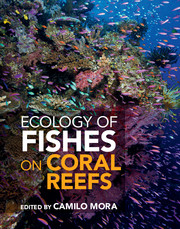Book contents
- Frontmatter
- Contents
- Preface
- Foreword
- List of contributors
- PART I BASIC ECOLOGY
- PART II PATTERNS AND PROCESSES
- 6 The evolution of fishes on coral reefs: fossils, phylogenies, and functions
- 7 Phylogeography of coral reef fishes
- 8 How many coral reef fish species are there? Cryptic diversity and the new molecular taxonomy
- 9 Large-scale patterns and processes in reef fish richness
- 10 Patterns and processes in geographic range size in coral reef fishes
- 11 Patterns and processes in reef fish body size
- 12 Multi-scale patterns and processes in reef fish abundance
- PART III HUMAN FINGERPRINTS
- PART IV CONSERVATION
- PART V DEBATES AND PARADIGM SHIFTS
- References
- Index
8 - How many coral reef fish species are there? Cryptic diversity and the new molecular taxonomy
from PART II - PATTERNS AND PROCESSES
Published online by Cambridge University Press: 05 May 2015
- Frontmatter
- Contents
- Preface
- Foreword
- List of contributors
- PART I BASIC ECOLOGY
- PART II PATTERNS AND PROCESSES
- 6 The evolution of fishes on coral reefs: fossils, phylogenies, and functions
- 7 Phylogeography of coral reef fishes
- 8 How many coral reef fish species are there? Cryptic diversity and the new molecular taxonomy
- 9 Large-scale patterns and processes in reef fish richness
- 10 Patterns and processes in geographic range size in coral reef fishes
- 11 Patterns and processes in reef fish body size
- 12 Multi-scale patterns and processes in reef fish abundance
- PART III HUMAN FINGERPRINTS
- PART IV CONSERVATION
- PART V DEBATES AND PARADIGM SHIFTS
- References
- Index
Summary
The advent of large-scale DNA sequencing has reopened the question of how many species of coral reef fishes currently exist and challenged our preconceptions of the definition of species. While the majority of species are characterized by distinct mitochondrial DNA lineages (monophyletic sets of haplotypes), well separated from related species, the frequent exceptions suggest that there are many more species, perhaps two or three times as many as are currently recognized. Genetic surveys, including the FISH-BOL project (which has compiled the “barcode” mtDNA COI sequence for 10 000 fish species to date), have revealed that a wide variety of nominal reef fish species contain distinctly different mitochondrial lineages, often with only minimal differences in phenotype (cryptic species), signifying populations that are (or were) reproductively isolated. Several patterns of cryptic lineages are found: nominal species breaking up into species complexes, usually parapatric but occasionally sympatric; pan-Indo-Pacific species dividing into parapatric ocean lineages; and “overlooked” species in groups with drab or silvery color, conserved morphology, or small size. Geographic scale and dispersal ability explains some of the patterns observed; in the Caribbean only families with both benthic eggs and short larval lives break up into parapatric complexes of cryptic species. On the vastly greater scale of the Indo-Pacific region, the relationship is less clear, although the widest-ranging panmictic species do have relatively large and/or long-lived larvae. Future research on sympatric cryptic lineages and species, especially the outcome of co-occurring cryptic lineages in zones of overlap, should clarify the taxonomic issues for many fishes.
The question of how many species of coral reef fishes currently exist was considered to be a mostly settled issue until the past decade, with the number of about 5000–8000 usually cited [40, 1083, 1398, 2149] and then peremptorily relegated to the introductory paragraphs of books. The variation in the number depended mostly on competing definitions of a “coral reef fish” and the estimate of undiscovered species in remote and deep habitats [e.g. 2050], rather than the more vexing question of the definition of a species.
- Type
- Chapter
- Information
- Ecology of Fishes on Coral Reefs , pp. 76 - 87Publisher: Cambridge University PressPrint publication year: 2015
- 28
- Cited by

